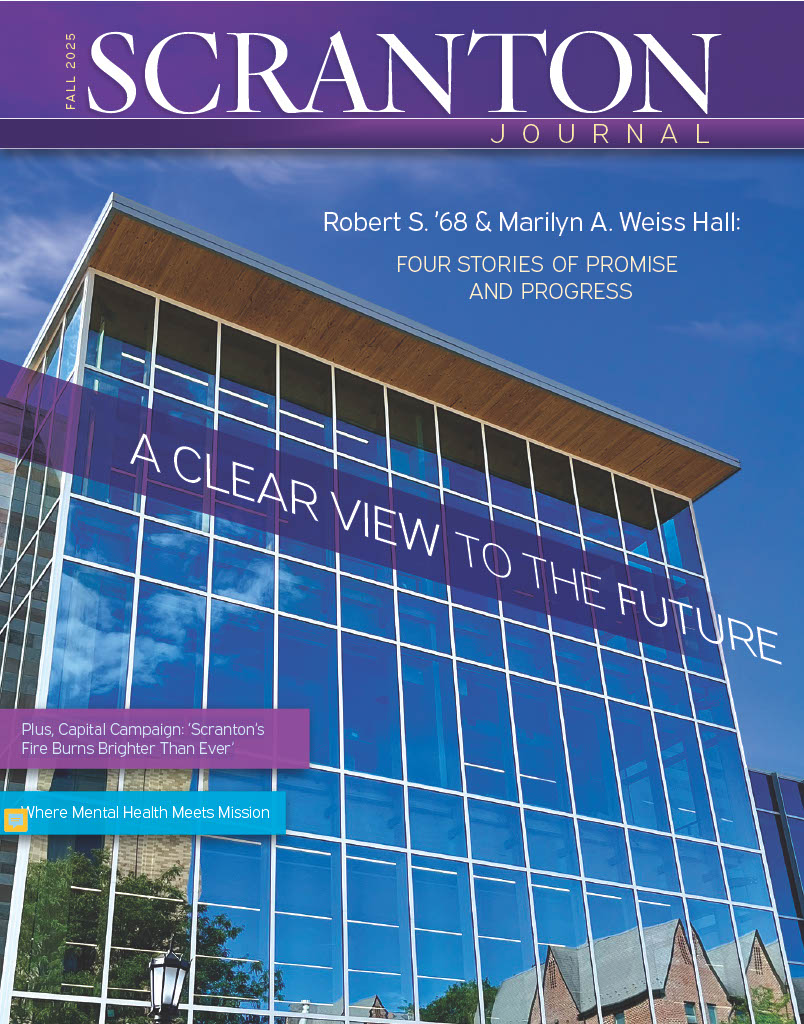Once upon a time, at Scranton’s Everhart Museum, North Scranton native Richard Stanislaus G’98 fell in love with the work of John Willard Raught (1857-1931), a Dunmore-born artist whose unique paintings placed the beauty of the coal breaker on par with the beauty of the French countryside. Now, decades later, as the guest curator of an exhibition of Raught’s work at the University’s Hope Horn Gallery, Stanislaus has given a new generation of art appreciators that same chance to fall in love with Raught.
“I was captivated by the bright, beautiful colors of Ridge Row, The City of Scranton and Harrison Avenue Bridge,” Stanislaus said in a recent interview with Josephine M. Dunn, Ph.D., professor of art history and affiliate faculty in women’s and gender studies at the University, that was published in John Willard Raught: Beauty Lies Close at Home, a three-volume catalog on Raught’s life and work assembled for the exhibition. “The work is accomplished in an Impressionist style of high-keyed colors, rough gestural brushstrokes, thickly applied paint and a recognizable subject — the city of Scranton.”
Throughout the 1960s and 1970s, Stanislaus researched Raught’s life and work, tracking down local citizens who had encountered the artist before his demise in 1931.
“I began recording what I heard about Raught, and my youthful transcriptions became the foundation of a body of research that today is quite comprehensive in nature and scope,” Stanislaus told Dunn. “In effect, I have devoted a lifetime to the study of an artist who was also a childhood hero.”
After high school, Stanislaus served in the United States Army before attaining his bachelor’s in art history from Kean College. He earned a certificate in appraisal studies and decorative fine art from New York University before earning his master’s in American history at the University with the thesis The Anthracite Coal-Breaker Paintings of John Willard Raught. He then earned a master’s in studio art from Marywood University with a concentration in printmaking.
Along the way, he honed his artistic skills with apprenticeships in painting restoration and printmaking and was featured as a United Nations Children’s Fund (UNICEF) greeting card artist. Eventually, he became a curator for the Luzerne County Historical Society, where he mounted the exhibition “Images of the Mines: Anthracite Coal Art 1869-1939.” Afterward, he served as registrar of paintings at the Everhart Museum before becoming a museum curator with the Pennsylvania Historical and Museum Commission, where he received assignments at Eckley Miners Village in Weatherly and The Anthracite Heritage Museum in Scranton. He retired from his career as a museum curator in 2016.
All the while, he collected everything he could find related to Raught, including his paintings, essays and personal items.
“I continued my research on Raught,” he said in the interview. “When my income allowed, I began to acquire more paintings. As my knowledge of methodologies of historical research and history of American art grew, so did the sophistication of my research.”Over the decades, Stanislaus encountered several other art enthusiasts whose interest in Raught mirrored his own. After he retired, he approached Darlene Miller-Lanning, Ph.D., director of the Hope Horn Gallery, and Dunn, who had been Stanislaus’ thesis advisor at the University, with the idea of organizing all his collected materials into an exhibition of Raught’s life and work. As they began working on what would become John Willard Raught: Beauty Lies Close At Home, they were approached by Raught’s great-niece, Rebecca Jeffrey Easby, Ph.D., associate professor of art history and chair of the Fine Arts program at Trinity University, who wished to contribute an essay on Raught’s family to the project. Lastly, they asked Sarah J. Moore, Ph.D., professor of Art at the University of Arizona, to contribute an essay on the cultural and historical context surrounding Raught’s work. Together, the team set out to create an “initial introduction to Raught’s oeuvre.”
“Many separate things came together in the right place at the right time,” Miller-Lanning said of the events surrounding the project’s creation. “In my work at the gallery, I’ve learned that the universe will gather and give you what you need.”
The catalog features reproductions of several of Raught’s works, essays by Stanislaus, Dunn, Miller-Lanning, Jeffrey Easby and Moore, various writings Raught composed for newspapers and academic journals and selections from historical sources, including a Raught family scrapbook. Together, these materials provide an invaluable overview of the life and work of John Willard Raught, ensuring his work will continue to inspire future generations.
“The ‘Raught Project’ seemed to grow of its own accord over a long passage of time and through the cooperation of many individuals,” Stanislaus said in the interview. “I saw a work of art that inspired and haunted me, and my curiosity was aroused to know more.”
“John Willard Raught: Beauty Lies Close At Home” opened at the Hope Horn Gallery in September with a lecture by Stanislaus.






